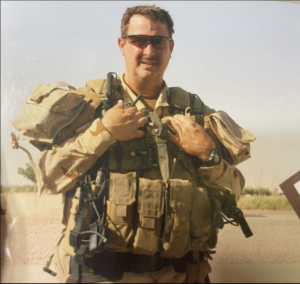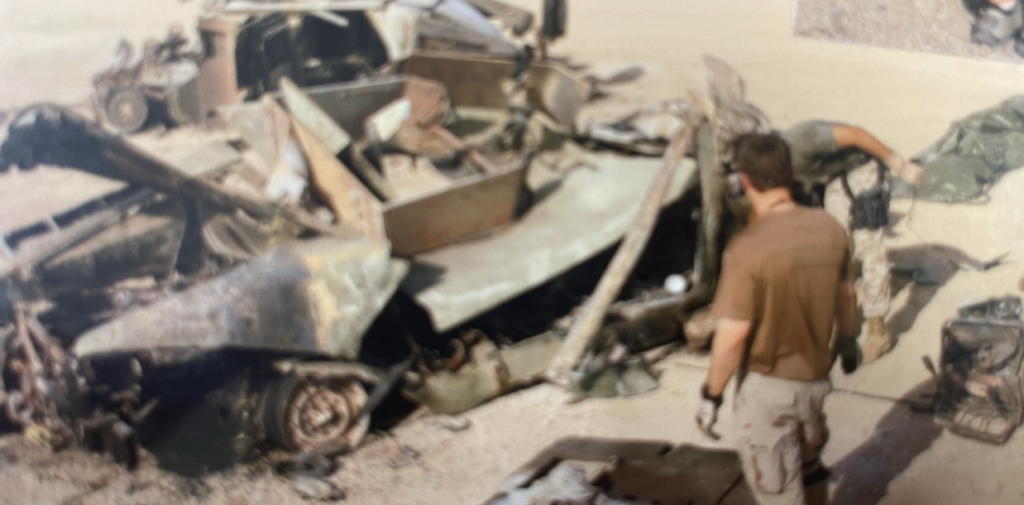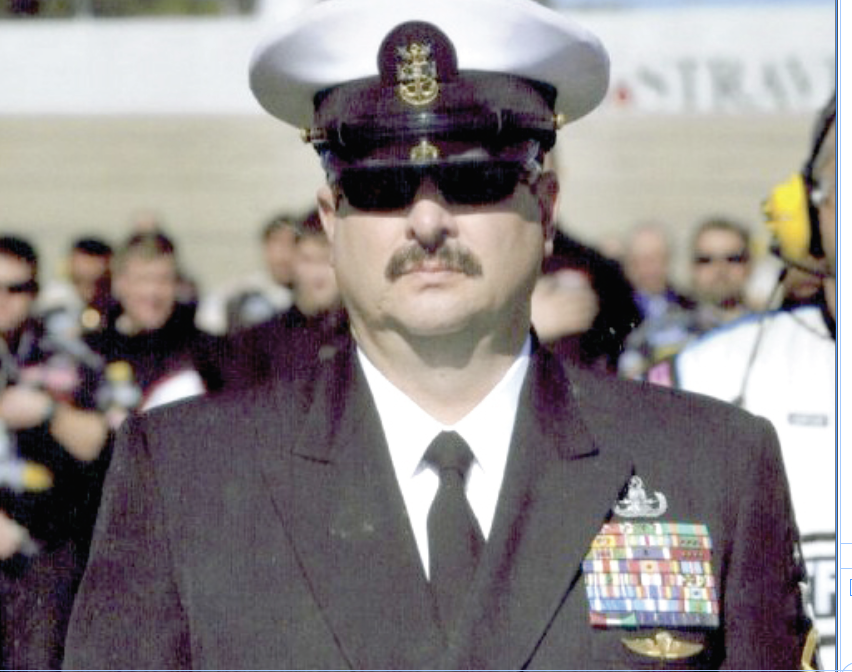Nesbitt spends Navel career as EOD Diver
By Tammy Curtis, Publisher
Often times we never know the impact the lives of people in our community have on history. Nothing is more true than of a formerly delusional high school baseball player who knew his life would be as an Atlanta Brave. From diving in world’s sea’s deactivating bombs for the Navy to forensically examining explosive materials from the Iraqi War, Poughkeepsie veteran Bill Nesbitt has made a huge impact on the world through his nearly three decades of service to American in the United States Navy during his six deployments to the Middle East. Four of these were combat missions.
Why the Navy?
As a young man, growing up mostly in Cave City but also in Batesville and Mountain View, Nesbitt graduated in 1984. What his future would hold was something even he never imagined. Hoping he would play baseball and become an Atlanta Brave was but a dream. The pinnacle of his baseball days was playing Legion Ball for three years.
His life was about to get much more exciting that hitting a grand slam.
Two days after his last season was over, Nesbitt was working on a clean up crew in a 130 degree plus heat at Con Agra spraying down a chain belt with Ronnie Caraway, a former National Guard guy from Mt. Pleasant. “I looked at him and said, ‘Caraway, I aint doing this until I am 65,” he laughed. While he had previously visited with an Army recruiter, it wasn’t something he had set his mind on at this time.
One night while at the local Moose Club, Nesbitt was talking to an Army recruiter and told him he would love to become a diver. The recruiter assured him that could be a reality in the Army. At this point, Bill began thinking about military seriously.
Initially, he and friend, Rob Alwin were planning on going to go into the Army on a buddy program, but backed out at the last second. He was again at the Moose one night talking about being a diver in the Army and a guy sitting next to him began laughing. Chance would have it that the man was a Navy recruiter. “Come on man, the Navy is where all the water is.” Mike Milan turned out to be his recruiter. “I tell people how many times in my life I have got lucky so many times, that was the first time.”
He said the first time he took the ASVAB test he just filled in the blanks haphazardly. He was encouraged by the recruiter to take it again. The recruiter explained to him the score is what opens every door for him in the Navy, “It turned out my second string of luck was I made a 92 on the thing and 98 was the high.” To get into special programs a combined ARBE score of 110 is required. He scored 121.
He’s in the Navy now
Nesbitt went to boot camp in San Diego on Christmas Day in 1984. His third string of luck came was while in the camp. The third day they had to do what is called “drown proofing”, which meant if you couldn’t swim you can’t be in the Navy. Basic swimming skills were tested just to make sure they were actually able to swim. Bill explained a man came out and asked who would like to take the PT test for Explosives Ordnance Devices and SEAL. With his teeth chattering, Bill joined the few other guys who raised their hand and he put his up.
Out of 125 guys n his boot camp company, 31 took the PT test which required then to swim 500 yards in under 10 minutes, do push ups, sit ups, pull ups and run a mile in a half. “I had never trained for anything like that. I got in the water, I didn’t know what the breast stroke or combat side stroke was,” he explained. He did them all and the run. “You don’t know how you are doing, you don’t have a watch on, they aren’t telling you So, we get done and he tells us “You are the only one who passed it,” indicating Bill was the sole person in the group.
He then put on his Navy dungarees and white hat and was ordered to report to “the motivator,” who was an old shot up Vietnam era Seal. He said that was the first time he had even stood at attention. He asked him why he wanted to be a Navy Seal. “I said sir, my girlfriend in high school used to love magnum PI.” he laughed. The man told him his ASVABS were off the charts and said he would make a much better bomb tech. He explained to Bill,“You get to jump out of planes, you get to dive and blow stuff up for a living.”
Bill then made his way up the coast to Treasure Island in San Francisco to a Hull Technician Ace School. While there, a few weeks before completing the course, he got orders to go back to Basic Underwater Demolition (BUD) School or SEAL School.
He went to San Diego and check in with a Master Chief and the man on deck asked him why he wanted to be a Navy Seal. He said the standard Magnum PI answer was not the same. He said, “I thought I wasn’t going to be, I thought I was going to EOD school.” The Master Chief, they call a “Twin Pin”, who was both a Seal and EOD guy, agreed BIill would be a better EOD technician. He got his orders changed, and went to EOD Mobile Unit Three on Coronado as a Perspective Student Under Instruction (PSI) for six months. This training time was used to get him in shape before going to school. “If I would have started in BUDS that next week, I would never have been in shape. I would have been in the fleet and two years later, I would have been back working at that chicken plant.”

During the school, he was taught how to swim a lot and run. From there, he went on to an18 month EOD School. Bill was first an assistant, working at a mobile unit and then went back after he made E5. After the EOD School was done, he went to Second Class Dive School. The strenuous schedule begins with 5 am. PT until 8 a.m., followed by all day classes until 4 p.m. and return for night classes until 10 p.m. During this time, he learned all foreign and domestic munitions, typed by function, including chemical, biological and nuclear.
He served as an assistant during the Tanker Wars. The biggest event in his Naval career, began just before they arrived in Oct. 1987, the U.S. sank a 42 foot long Iranian Boghammar high speed patrol boat that was always harassing the tankers. One of the US C Bat helicopters sank the boat after it shot at the helicopter. When they came over, they located the boat and came back later after clearing the mine filed it was submerged in 160 feet of water. They hooked it up to a barge and put it on the barge, Under the cover of darkness, they got the barge on Hercules and started ripping it apart and found three US Stinger Missiles that had been sold to the Nicaraguans who had then sold them to the Iran during the Iran Contra Scandal. “That was such a significant event.”
Bill explained mines on the bottom utilized acoustic, magnetic, seismic motion. When a ship goes over it, the mine senses the magnetic signature and creates a bubble, and the ship hits it nothing is holding the hull up and the hull flexes and then the blast hits it and sinks the ship. “Bottom mines are bad,” he said.
Graduation from EOD School
Dec. 1, 1989 Bill graduated EOD school and 6-8 months later Sadaam Hussein invaded Kuwait. Right after the invasion, they were put on the short list and began preparing to go over by attending special schools from August until January.
On Jan. 16 they landed in Bahran and started loading out on the civilian oceangoing tug Celina as a special deep diving team. The ship had decompression chambers. Divers could safely dive up to 300 feet with the equipment aboard the ship.
During March in Operation Desert Storm Bill and his team began going out at low tide searching for mines. Due to the high tidal shift, the moored mines are closer to the surface and are more easily visible. They are made to hit a ship under the water line. Bill and his crews swam up to many mines and tied a charge off to the bottom and then lit a time fuse that allowed him time to get back to boat and move a couple hundred yards out of the way before blowing them.

April 19, 1991,
Persian Gulf.
The bottom mines also “listen” for the diver’s actvity. Their $80,000 diving equipment was a closed circuit, mixed gas rig that emits no sound as they approach the mines. The diverS operated in a small boat off a mother ship with Magellan GPS. They dove and attached det cord down to the mine and then attached blasting caps and a time fuse to it. The men then popped the smoke and waited as it burned on the surface waiting for the mines to explode. The exploded over 50 bottom mines one at at time. “We started getting braver with it and began blowing multiple mines at once.”
He told of one very scary incident with a UDM, one of the larger Russian mines they detected. As he dove down, the large mine was still in its original crate standing on its end, moving and digging a hole in the ocean floor with the current with a portion already buried. Once they get down to the mine, the divers listen to the sonar and as they approach the signal sound changes, indicating they are close.
Once Bill got down to the large mime and tied off, he had to wait until the mine moved to the other side of the hole from the motion, and tie off the det cord little at a time, being extremely quiet and even swimming pulling himself without making any current, basically sneaking up on the mine. He finally reached in and got it tied up and a giant grouper fish swam very close to him, scaring him.
He then followed the deck cord to the surface to make sure it was free of knots or tangles that could result in a misfire. As he explained, seven countries are all out blowing mines with no coordination between any of the countries in clearing the mines.
As he was coming through the last 80 foot of water toward the surface, he felt vibrations and sound and was terrified and swam to surface quickly and got in the boat ,still scared. No one on surface heard it, because sound travels faster underwater. One of the other countries had blown a mine in the vicinity of where he was diving.
Other challenges for divers like Bill included diving in oil slicks after tanker terminals were bombed. Once, they time had to swim out nine miles of pipeline over a week time frame from the offshore terminal to the because the mine sweepers wouldn’t work in the oil.
The oil slicks were so bad when they first started they had to take a boat paddle to knock a hole in the top of the water for him to get in to dive. Bill and his teams searched Kuwait City Harbor, Shewaba Harbor, a very large harbor. Every square foot of the harbors had to be searched to make sure they weren’t mined
“What an amazing life for a kid, riding around in a boat in silky shorts and blowing things up with a team full of buddies,” Bill said laughing.
When they found the first mine of any type they were required to raze it. They put a charge away from the mine and over pressurized it, they then put a lift on it and pull it to the surface, drag it to the beach. Once there, the team of technicians tear it apart to determine how it functions. They examine frequency and determine what the mine what it is “looking for” to cause detonation.
Luckily, the only injury his diving team incurred was when one diver on another team suffered from possible Bends.
Desert Storm
During Desert Storm, the team later advanced their operations aboard Kiowa helicopters utilizing a metal ladder on a harness spotting floating mines. They did this during low tide. When the mines were spotted the divers were dropped in the water and swam to them, put a charge on the mines and swam back to the ladder.
Getting out of the Navy and back in
In June of 1991, Bill returned to the United States and shore duty in Charleston, S.C.
This was the only retrograde disposal range on the East Coast. Everything coming back from Desert Storm on the ships, like powder for shooting projectiles was brought there. They were tasked with taking it to the range to get rid of it. Over 3 million pounds of smokeless powder was disposed of during his time there. The men were shooting 10 shots 850 pounds shots a day of demolition. He remained at Charleston for three years as the U.S. was consolidating teams and about to shut them down.
It was then that he received orders to go to San Diego, and did not want to go. He got out of the Navy in 1994 and came home and played softball for a few years.
Two years to the date he left the Navy, he got a phone call from a recruiter asking him to get back in as a First Class EOD technician with a $20,000 sign on bonus. In Feb. 1996, he went back in.
Training Dolphins
He went back to EOD Mobile Unit Three where he first went and was met by an old friend of his who recently passed away. He went active in June. They put him in a marine mammal unit. He laughed and said, “They put me in with dolphins.” He began training dolphins, which are used to detect moored mines, bottom mines and for harbor security to protect ships from swimmers coming in and placing items on ships. He said dolphins are very smart, and they pretty much trained him. Bill hated training dolphins. This was problem that soon self corrected. “They had about $5 million in training invested in me and I am there doing Sea World crap. I told him I can drive down the road and find one of those dudes with a sign saying ‘Will work for food’ and in 30 minutes have him training a dolphin. I didn’t go to EOD school to learn how to train a dolphin.” He said he was graded for training his dolphin Kaheeli. “I called him K-Dog,” he laughed. They are trained by a reward system of providing them fish to eat as a treat and if they don’t do as instructed the reward is withheld. “I got mad at him one day and hit him with my flip flop and I got fired.”
Bill explained that was another lucky thing that happened to him, because he wanted on an EOD Team and the dolphin incident ended up getting him his team. They cruised on USS Boxer and went from Hawaii to Hong Kong, Bali, Indonesia, Thailand among other places.
At the time, Bill explained, Eritriea and Ethiopia were in a war and they wanted their whole battle group to go to the Red Sea in case humanitarian operations were needed. He said they spent 52 boring days in the Red Sea. One day, they decided to do some air operations Bill was the Helicopter Rope Suspension master. He said he carefully instructed the female pilot that when they go out to bank right so she can see could see them, she banked left. “We spent the next eight hours floating in the Red Sea.
They spent 30 days in Bahrain, hit Bali, Indonesia and Australia in 98-99 and he Made Chief E 7 while he was there. This was followed by two peaceful years of training and becoming more educated before 9/11.
9/11 Changes things
“I was crossing Coronado bridge one morning, drinking coffee and minding my own business. I turned on the radio. It sounded like war of the worlds. I was a Chief in charge of Training Team Alpha EOD teams In San Diego and certifying them.” This when the first dose of reality hit and he realized the planes were terrorists, and said he knew the nation was at war.
At this time, he was set to transfer to another command. They sent guys over and had guys in Afghanistan by Oct. 8.
He was in Texas for two months about six months after Afghanistan planning due to his vast experiences with mines and the knowledge of what Sadaam Hussein had done previously
Bill transferred to Group One and deployed to Bahrain in Feb. 2003 and spent a month there before moving on to Kuwait Naval base, where he had been 10-12 years earlier, arriving five days before they were due to cross the border into Iraq.
“We spent the night at the Kuwaiti Naval base and went to one of those Marine outposts, Bull Rush,. and slept on the hood of a Deuce and Half in a gas mask for three days.” They were more than ready to move the morning they crossed the border into Unkassar. Our mission was to take the port and clear the mines if they were present. They had Marine Force Recon, Seals and EOD and took the port and brought the dolphins. “The dolphins were the only ones who could operate because the current was so strong we couldn’t put a diver in. We had to in order to bring humanitarian aid so the ships could come in.”
While in Iraq, Bill made E 8, Senior Chief and came back to the states and began training a unit to train teams for Afghanistan as Iraq started really ramping up. He trained through 2003-2005.
The very first Explosively Formed Penetrator (EFP) causality in the Iraqi war was Josh Markum in 2005. Markum was from Evening Shade. While the story was he was killed by a pressure plate Improvised Explosive Device, it was actually a very unique IED.
Bachelor’s Degree in Forensics
During this time Bill was also working on his first Bachelor’s degree in forensices at CEXC (Combined Explosive Exploitation Cell … Pronounced SEXY) in Iraq. Bill was given the opportunity to be the senior enlisted for the special unit, comprised of Australian and British bomb technicians, national ground intelligence, Defense Intelligence Agency, Central Intelligence Agency and about 30 latent print forensic specialists. Their job was to go around Baghdad doing forensic recoveries at explosion sites. If a bomb had defeated the counter measures of the truck or killed American’s Australians or a significant event, they were called to do the post blast recovery. He was there almost 7 months and all of the explosive devices from Iraqi were sent to their unit. They would get the device, X-ray it to determine it was explosively safe and assign it a priority, if it had killed a coalition troop or other significant damage, had to be labeled red and put on a plane and sent to the FBI to the Terrorism Explosive Device Analytical Center. (TDAC) at Quantico within 24-48 hours.
We were a direct arm of the FBI. He said he had became educated through the FBI academy TDAC and other important schools to learn what he would be doing. “In that six months time we touched in one way or another, 4200 plus IEDs.” He said they were overwhelmed with the number of IEDs they were getting and sent out a Naval message to any ship, unit or other in theater to send any knowledgeable electronic technicians to be sent to him for help processing the devices. They would reverse engineer the bombs to determine what sounds the bomb programmer used to detonate the bombs and classify each and determine the counter measures to defeat the bombs.
He told a funny story about his technicians having to taking an hour to walk to the chow hall and an hour to walk back, wasting valuable work time. He remedied it by having an Iraqi partner help him come up with vehicles to carry them to and from chow . This created an ongoing battle with a Command Sgt. Major who kept confiscating his vehicles. He recalled giving a VIP tour of CEXC to a two star General and his entourage. He noticed Bill’s Southern accent and told him he was from Northcentral Arkansas. “I said you probably never heard of it. He said try me, I said Cave City, he said he was from Jonesboro and graduated from ASU in 1972 and showed him his championship football ring. He said he was impressed with the program and then asked if there was anything he could do to help, He told him about the Command Sgt. Major confiscating his vehicles. He turned around and asked him if would have his vehicles back to him that night, and he did.
Titanium exposure
In 2006 he was exposed to titanium dust in Iraq, causing damage to his lung. This is closely monitored with CT scans. Bill came home in Dec. 2006 from CEXCE and went back in April through June and came home and went back to Mobile Unit 3 and took a team and trained and went back to Anbar Provence in 2008. He and three guys worked the whole Euphrates River
June 20, 2008 one of their trucks was blown up and he came back from that deployment in October. “We didn’t no more get back because it was an election year and were stateside and had to work Secret Service for Obama in Grant Park in Chicago,” he explained.
“Afghanistan was a completely different animal. In Iraq an IED would go off and somebody would shoot an AK47 around the corner, it was not really effective.. In Afghanistan if an IED went off, it was an 8 hour gun fight,” he explained of the differences between the two wars. .
Ironically, while there, Bill received a call that he achieved the rank of E9, Master Chief. Within 72 hours, he was back in the states and finished up his career in Millington, Naval Station.
While there, Bill was the national program director for all Naval special warfare and special ops recruiting for COED Dive. He ran all 26 districts in the United States.
Among his medals are Three Bronze Stars, a Meritory Service Medal, Seven Navy Commendations, five with valor. Last week, Bill was inducted into the Arkansas Military Hall of Fame for his service to America during his 28 years in the Navy.
He doesn’t like to be called a hero, but is very proud of his career and the realization that as a bomb technician, he is in fact very lucky as during his time, 14 men were killed doing the work he did and even a few more since he has gotten out of the Navy.
Bill will complete the Ozarka College Culinary School this week and began a job as a chef at Gaston’s Resort. He has enjoyed his life but due to his lung injury but makes the most of life with friends and reflects fondly on his military career.

